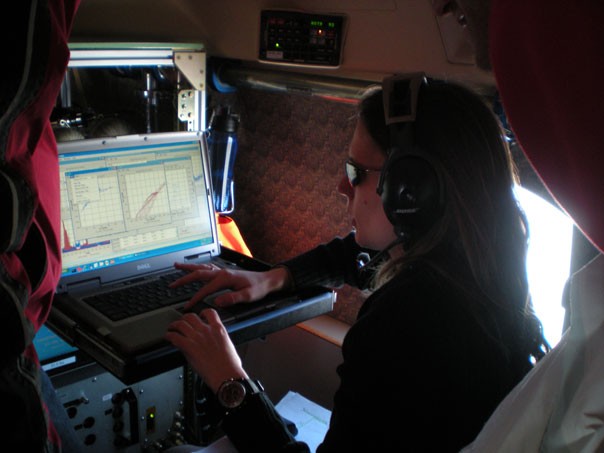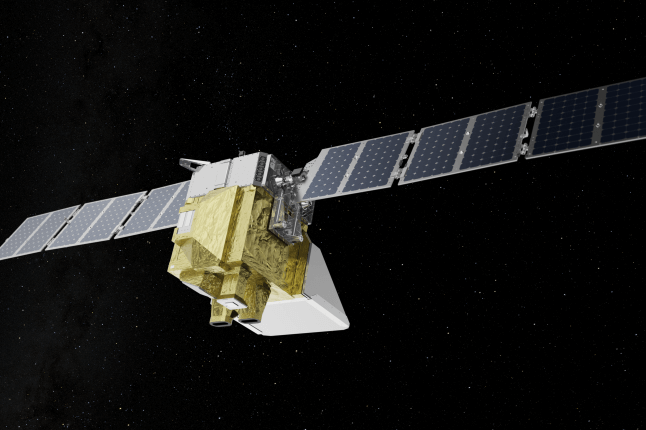News
NSF's Gulfstream V aircraft, or HIAPER, in Anchorage, Alaska, during a HIPPO mission. (Credit: UCAR, Carlye Calvin.)
CONTACT: Caroline Perry, (617) 496-1351

The view from the Gulfstream V, High-performance Instrumented Airborne Platform for Environmental Research (HIAPER), during a research flight. (Photo by Bruce Daube.)
Cambridge, Mass. – February 12, 2013 – Data from the HIAPER Pole-to-Pole Observations (HIPPO) study of greenhouse gases and aerosols are now available to the atmospheric research community and the public.
This comprehensive dataset provides the first high-resolution, vertically resolved measurements of over 90 unique atmospheric species collected during a series of nearly pole-to-pole flights over the Pacific Ocean, across all seasons. The suite of atmospheric trace gases and aerosols is pertinent to understanding the carbon cycle and challenging global climate models.
The dataset will provide opportunities for research across a broad spectrum of Earth sciences, including those analyzing the evolution in time and space of the greenhouse gases that affect global climate.
Two websites, created by the National Center for Atmospheric Research (NCAR) Earth Observing Laboratory and the U.S. Department of Energy’s Carbon Dioxide Information Analysis Center (CDIAC), debuted on November 30, 2012, to serve those interested in acquiring HIPPO data and documentation.
“These highly detailed cross sections are analogous to tomographic images that reveal the inner workings of the atmosphere and the underlying surface,” says principal investigator Steven C. Wofsy, Abbott Lawrence Rotch Professor of Atmospheric and Environmental Science at the Harvard School of Engineering and Applied Sciences. “For many years our team had dreamed of a data set of this kind, and we are delighted that the measurements have now been made and are available to the whole scientific community.”
HIPPO was a multi-year global airborne research project, funded by the National Science Foundation (NSF) and the National Oceanic and Atmospheric Administration (NOAA), that surveyed the latitudinal and vertical distribution of aerosols and greenhouse and related gases. Project scientists and support staff flew five month-long missions over the Pacific Basin on the NSF/NCAR Gulfstream V, High-performance Instrumented Airborne Platform for Environmental Research (HIAPER) aircraft between January 2009 and September 2011, spread throughout the annual cycle, from the surface to 14 kilometers in altitude, and from 87°N to 67°S.
The landmark study resulted in an extensive, highly detailed dataset of over 90 atmospheric species, from six categories, all with navigation and atmospheric structure data, including greenhouse gases and carbon cycle gases; ozone and water vapor; black carbon and aerosols; ozone-depleting substances and their replacements; light hydrocarbons and PAN; and sulfur gases/ocean-derived gases. A suite of specialized instruments on the aircraft made high-rate measurements as the plane flew, while several whole air samplers collected flasks of air for later analysis in laboratories around the U.S.

Jasna Pittman, a research associate in atmospheric sciences at Harvard, examined real-time measurements of various chemical species while flying over Arctic waters in March 2010. “Alaska is incredible, absolutely breathtaking. We were there in the wintertime, so you could see all the mountains covered in snow, beautiful blue skies,” Pittman told the Harvard Gazette. “You look out far away, and you see this layer of haze.” (Photo by Bruce Daube.)
The flights were conducted in a continuously profiling mode, with the aircraft alternately climbing or descending as it flew from its home base in Broomfield, Colo., north to Alaska and the Arctic, south down the middle of the Pacific Ocean to New Zealand and the Southern Ocean near Antarctica, and then back to the Arctic a second time before returning home. In all, the aircraft made 64 flights and flew 787 vertical profiles while covering 285,000 km. The instruments collected 434 hours of high-rate continuous measurements during the five HIPPO missions, and 4,235 flask samples were collected.
“The field efforts were highly successful, and these unique measurements are providing key insights into the global carbon cycle and aspects of the climate system,” says co-principal investigator Britt Stephens, of NCAR.
A Sampling of HIPPO Results
One of HIPPO’s most significant accomplishments has been quantifying the seasonal amounts of carbon dioxide taken up and released by land plants and the oceans. Those measurements complement ongoing independent surface observations in helping scientists determine the magnitude of the annual cycle of carbon dioxide moving in and out of the atmosphere and how the increasing amount of this gas is influenced by both natural systems and industrial activity. Global carbon cycle data from HIPPO are already showing how global models can be improved. The data will help scientists calibrate observations collected in other ways, such as through ground-based spectrometers and satellite-borne instruments.
Another key finding was that concentrations of methane—an important greenhouse gas—very near the surface of the Arctic Ocean were elevated compared to air aloft, indicating unexpected sources of methane over the open ocean. As with the carbon dioxide, the methane data nicely augment ongoing surface-based observations, provide a critical test for satellite-based measurements, and ultimately will improve estimates of surface methane sources.
The team found that black carbon particles observed on the first HIPPO flight series—emitted by diesel engines, industrial processes, and fires—were less widely distributed in the atmosphere than previously expected. Such particles can affect climate in various ways, such as by directly absorbing solar radiation, influencing the formation of clouds or enhancing melt rates when they are deposited on ice or snow. In later HIPPO series, plumes of smoke from fires over Southeast Asia contributed to large amounts of black carbon above the North Pacific, while much lower amounts in the Southern Hemisphere were also observed.
Researchers were also surprised to find elevated concentrations of nitrous oxide high in the tropical atmosphere. The finding has significant environmental implications because the gas both traps heat and contributes to the thinning of the ozone layer. Nitrous oxide levels have been increasing for decades in part because of the intensive use of nitrogen fertilizer for agriculture. The abundance of the gas high in the tropical atmosphere may be a sign that storms are carrying it aloft from sources in Southeast Asia.
The HIPPO data set clarifies the importance of the Southern Ocean in both taking up oxygen during the winter and releasing it in the summer. These results will feed into studies of ocean biogeochemistry and will help test models of the feedbacks between carbon and climate.
HIPPO Data Archives
CDIAC HIPPO Data Archive: http://hippo.ornl.gov/
Integrated measurement data products and user documentation are provided at the Carbon Dioxide Information Analysis Center (CDIAC) HIPPO data archive. Files are in ASCII text format. Products include:
- A comprehensive merged product at 10-second resolution for all high-rate measurements (40 measurements of 26 unique species, not counting flask measurements)
- Combined results from all discrete whole air sample and gas chromatograph measurements (77 unique species)
- Pressure-weighted mean column concentration data for total and 10 km columns and 100 m vertical intervals
- A subset of all measurements from NOAA flask samples that are directly comparable with data from the NOAA/ESRL/GMD CCGG cooperative air sampling network
- A subset of measurements from the MEDUSA flask sample trace gas and isotope data with additional diagnostics
EOL HIPPO Data Archive: www.eol.ucar.edu/projects/hippo/
The Earth Observing Laboratory (EOL) HIPPO data archive provides component data, documentation, and information, including:
- Photos, imagery, and movies from an aircraft-mounted camera with time-synchronized navigation and state parameter data
- Files of merged data from the aircraft, at 1-second intervals
- Pole-to-pole atmospheric cross-section plots of chemical species
- Investigator-provided quality-assured individual instrument data files
- Supporting data sets (e.g. operational satellite, model output, global observations, etc.)
- Ancillary flight information, field catalogs, data quality reports, software, and documentation
###
Adapted from an original release by NCAR.
Topics: Environment, Climate
Cutting-edge science delivered direct to your inbox.
Join the Harvard SEAS mailing list.
Scientist Profiles
Steven C. Wofsy
Abbott Lawrence Rotch Professor of Atmospheric and Environmental Science



